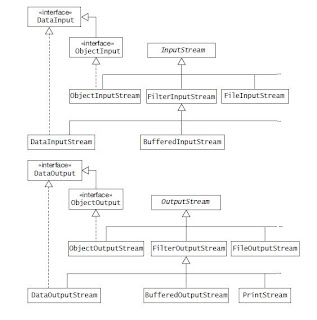javac -d path_to_classes_dir name of java file
The -cp option can be used to set the class path for each application individually
for example
-cp /pgjc/work:/top/bin/pkg:.
Here path-separator character ':' for Unix platforms to separate the entries, and also included the current directory (.) as an entry.
For windows it is ';' used as path separator
One cannot call method of base class using super keyword from static method.
Given below is example
class SuperCalc {
protected static int multiply(int a, int b) { return a * b;}
}
class SubCalc extends SuperCalc{
public static int multiply(int a, int b) {
int c =super.multiply(a, b); // wrong !! cannot use super from inside static
return c;
}
}
Class names and method names exist in different namespaces.
Collections.sort() // can only be used for List or its subclasses
Arrays.sort() // can only be used for object arrays or long[]
Default modifier is narrower than protected modifier . Method having default access modifier can be declared as protected in its sub class.
Default member accessibility is more restrictive than protected member accessibility.
A base class reference cannot be assigned to sub class reference . ( it will give compile time error ) if
type casted then will give runtime class cast exception.
but a subclass ref can be assigned to base class ref
Need to go through Locale / Date / Date format / Localization
An anonymous inner class can extend either one subclass or implement one
interface. Unlike non-anonymous classes (inner or otherwise), an anonymous
inner class cannot do both. In other words, it cannot both extend a class and
implement an interface, nor can it implement more than one interface.
this is not only a keyword its a constructor !
class Base1{
private int score;
private int goal;
Base1()
{
this(20);
}
Base1(int score)
{
//this.score=score; valid
this(score, 2*score);
}
Base1(int score, int goal)
{
this.score=score;
this.goal=goal;
}
void printScore()
{
System.out.println(" Score ="+score + "goal = "+goal);
}
}
addAll() , retainAll(), removeAll () are destructive operations .!! be safe while playing .
Generic Type classes cann't be instantiated !
nor Arrays can be formed of Generic Type .
The && and || operators are short circuit operators. A short circuit operator is one that doesn't
necessarily evaluate all of its operands. Take, for example, the operator &&. What happens when Java
executes the following code?
if (0 == 1 && 2 + 2 == 4) {
out.println("This line won't be printed.");
}
Realize that the condition (2 + 2 == 4 || whatever) must be true, no matter what
the whatever condition happens to be.
Field of an object is accessed using a reference, it is the type of the reference, not the class of the
current object denoted by the reference at runtime . It is called Field Hiding .
Interfaces are by default static , irrespective of their declaration.
Non static Inner classes can't have static members/ interfaces / static methods .
Only inner classes can be declared as static .
Interfaces cannot be static unless they are inside a class.
